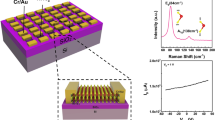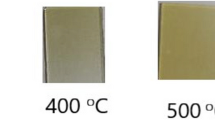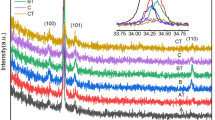Abstract
Thin films of zirconium niobium oxide (Zr0.7Nb0.3O2) were deposited by DC reactive magnetron sputtering method on unheated quartz and p-silicon substrates at different oxygen partial pressures. XPS studies confirmed the presence of zirconium, niobium and oxygen associated with Zr0.7Nb0.3O2 by showing the respective core-level binding energy values. The films formed at oxygen partial pressure of 4 × 10–4 Torr were of single-phase Zr0.7Nb0.3O2 with amorphous nature. Optical band gap of the films increased from 4.19 to 4.42 eV with an increase in oxygen partial pressure from 8 × 10–5 to 4 × 10–4 Torr. The Zr0.7Nb0.3O2 films formed at 4 × 10–4 Torr were also annealed in air at different temperatures in the range from 500 to 750 °C. The films annealed at temperature 600 °C showed a weak diffraction peak of tetragonal Nb2O5 with amorphous background. Further increase in temperature to 750 °C, the films transformed to polycrystalline with tetragonal structure. Shift in the diffraction angles revealed that niobium substituted the zirconium and form Zr0.7Nb0.3O2. The band gap of the films increased from 4.64 to 4.81 eV with the increase in annealing temperature from 600 to 750 °C. Metal–oxide–semiconductor (MOS) gate capacitors with configuration Al/Zr0.7Nb0.3O2/p-Si were deposited and studied the capacitance–voltage and current–voltage characteristics. The dielectric constant of the films increased from 15 to 23 with increase in annealing temperature from 600 to 750 °C. The leakage current density of the as-deposited MOS capacitors was 2 × 10–5 A/cm2 and decreased to 4 × 10–7 A/cm2 with the increase in annealing temperature to 750 °C due to improvement in the crystallinity and decrease in defect density in the films.













Similar content being viewed by others
Availability of data and material (data transparency)
The investigation has some innovative impact. Yes there is transparency in the discussed data.
Code availability (software application or custom code)
Not applicable.
References
F. Maik, H. Maria, D. Sebastian, J.S.V. Ruter, G.T. Dahl, K. Tobias, A. Kornowski, M. Ritter, H. Weller, V. Tobias, Synthesis and thermal stability of ZrO2@SiO2 core Shell submicron particles. RSC Adv 9, 26902–26914 (2019)
R. H. Piva, D. H. Piva, M. R. Morelli, Synthesis by coprecipitation of indium oxide stabilized zirconium oxide and co-doping with MoO3, WO3, TaO2.5 or NbO2.5 for application as thermal barrier coatings. Mater Res 19, 1 (2016)
S.W. Park, H.B. Im, Effect of oxygen conditions on the properties of tantalum oxide films on silicon substrates. Thin Solid Films 207, 258–264 (1992)
B. Orel, M. Macek, J. Grasadolnik, A. Meden, In-situ UV-Vis and ex-situ IR spectro-electrochemical investigations of amorphous and crystalline electrochromic Nb2O5 films in charged/discharged states. J Solid State Electrochem 2, 221–236 (1998)
L. Bocher, M.H. Aguirre, R. Robert, D. Logvinovich, S. Bakardjieva, J. Hejtmanek, A. Weidenkaff, High temperature stability, structure and thermoelectric properties of CaMn1-xNbxO3 phases. Acta Mater. 57, 5667–5680 (2009)
A. Graff, Y. Amouyal, Effects of lattice defects and niobium doping on thermoelectric properties of calcium manganate compounds for energy harvesting application. J Electron Mater 45, 1508–1516 (2016)
N. Li, M. Suzuk, Y. Abe, M. Kuwamura, K. Sasaki, H. Itoh, T. Suzuki, Effect of substrate temperature on the ionic conductivity of hydrated ZrO2 thin films prepared by reactive sputtering in H2O atmosphere. Solar Energy Mater Solar Cells 99, 160–165 (2012)
H.J. Quah, Z. Hassa, W.F. Lin, Passivation of silicon substrate using two-step grown ternary aluminium doped zirconium oxide. Appl Surf Sci 493, 411–422 (2019)
I.J. Berlin, K. Joy, Optical enhancement of Au doped ZrO2 thin films by sol–gel dip coating method. Physica B 457, 182–187 (2015)
J.S. Santos, F.T. Strixino, E.C. Pereira, Influence of experimental conditions on the morphology and phase composition of Nb doped ZrO2 films prepared by spark anodization. Corrosion Sci. 73, 99–105 (2013)
N. Sangwaranatea, M. Horprathumb, J. Kaewkhaoc, Deposition of transparent Niobium oxide thin film by DC reactive magnetron sputtering. Appl Phys Mater Application II 675, 217 (2016)
S. Uthanna, P. Kondaiah, M. Chandra Sekhar, R. Subba Reddy, G. Mohan Rao, Post-deposition annealing influenced structural and optical properties of RF magnetron sputtered TiO2 films. Int J Nanosci 10, 279–283 (2011)
J.H. Hong, W.J. Choi, J.M. Myoung, Properties of ZrO2 dielectric layers by molecular beam epitaxy. Microelec Eng 70, 35–40 (2000)
F.Y. Zhou, K.J. Qiu, D. Bian, Y.F. Zheng, J.P. Lin, A comparative in vitro study on biomedical Zr2.5X (X = Nb, Sn) alloys. J Mater Sci Technol 30, 299–306 (2014)
A. Juma, I.O. Acika, A.T. Oluwabia, A. Merea, V. Mikli, M. Danilson, M. Krunks, Effect of Zr doping on the structural and electrical properties of spray deposited TiO2 thin films. Appl Surf Sci 387, 539–545 (2016)
H. Brunckovaa, H. Kolevb, L. A. Rochac, E. J. Nassarc, S. B. Moscardinic, L. Medveckya, XPS characterization and luminescent properties of GdNbO4 and GdTaO4 thin films. Appl Surf Sci 504, 144358 (2020)
W. Zhang, W. Wu, X. Wang, X. Cheng, D. Yan, C. Shen, L. Peng, Y. Wang, L. Bai, The investigations of NbO2 and Nb2O5 electronic structure by XPS, UPS and first principle methods. Surf Interface Anal 45, 1206–1210 (2013)
J.P. Masse, H. Szymanowski, O. Zabeida, A. Amassian, J.E.K. Sapieha, L. Martinu, Stability and effect of annealing on the optical properties of plasma deposited Ta2O5 and Nb2O5 films. Thin Solid Films 515, 1674–1682 (2006)
J. Tauc, Amorphous and Liquid Semiconductors (Plenum Press, New York, 1974)
M. Brunet, H.M. Kotb, L. Bouscayrol, E. Scheid, M. Andrieux, C. Legros, S.S. Chardon, Nanocrysta-llized tetragonal metastable ZrO2 thin films deposited by metal-organic chemical vapour deposition for 3D capacitors. Thin Solid Films 519, 5638–5644 (2011)
N. Usha, R. Sivakumar, C. Sanjeeviraja, M. Arivanandhan, Niobium pentoxide thin films: RF power and substrate temperature induced changes in physical properties. (2015). https://doi.org/10.1016/j.ijleo.2015.05.036
B.D. Cullity, Elements of X-ray Diffraction, 2nd edn. (Addison Wesley, London, 1978)
S. Venkataraj, O. Kappertz, H. Weis, R. Drese, R. Jayavel, M. Wuttig, Growth and characterization of zirconium oxynitride films. J Appl Phys 92, 3599 (2002)
K.P.S.S. Hembram, G. Dutta, U.V. Waghmare, G. Mohan Rao, Electrical andstructural properties of zirconia thin films by reactive magnetron sputtering. Physica B 399, 21–26 (2007)
R. Swanepoel, Determination of films thickness and optical constants of amorphous silicon. J Phys E 16, 1214–1222 (1983)
L. Dong, R. Jia, B. Xin, B. Peng, Y. Zhang, Effects of oxygen vacancies on the structural and optical properties of β-Ga2O3. Sci. Reports 7, 40160 (2017)
S. Korkmaz, S. Pat, N. Ekem, M.Z. Balbag, S. Temel, Thermal treatment effect on the optical properties of ZrO2 thin films deposited by thermal vacuum arc. Vacuum 86, 1930–1933 (2012)
A. Benanej, A. Hassanpour, Modification of laser induced damage threshold of ZrO2 thin films by using time-temperature gradient annealing. Appl Surf Sci 258, 2397–2403 (2012)
J. Kim, K. Haga, E. Tokumitsu, Investigation of Nb-Zr-O thin film using sol-gel Coating. Semicond Sci Technol 17, 245–251 (2017)
S.V. Jagadeesh Chandra, J.S. Kim, K.W. Moon, C.J. Choi, Effect of post metallization annealing on structural and electrical properties of Ge metal-oxide-semiconductor (MOS) capacitors with Pt/HfO2 gate stack. Microelec Eng 89, 76–79 (2012)
S.V. Jagadeesh Chandra, M.R. Jeong, K.H. Shim, H.B. Hong, S.H. Lee, C.J. Choi, Effective metal work function of Pt gate electrode in ge metal oxide semiconductor device. J Electrochem Soc 157, H546-550 (2010)
S.V. Jagadeesh Chandra, G. Mohan Rao, S. Uthanna, Effect of substrate temperature on the structure, optical and electrical properties of magnetron sputtered tantalum oxide films. Appl Surf Sci 254, 1953–1960 (2008)
M. Kumar, S.V. Jagadeesh Chandra, M. Jua, S. Dutta, S. Phanchanan, S. Sanyal, D.P. Pham, S.Q. Hussain, Y. Kim, J. Park, Y.H. Cho, E.C. Cho, J. Yi, Effects of post deposition and annealing atmosphere on interfacial and electrical properties of HfO2/Ge3N4 gate stacks. Thin Solid Films 675, 16–22 (2019)
S.V. Jagadeesh Chandra, E. Fortunato, R. Martins, C.J. Choi, Modulations in effective work function of platinum gate electrode in metal-oxide-semiconductor devices. Thin Solid Films 520, 4556–4558 (2012)
Acknowledgements
Dr. S. Uthanna, one of the corresponding authors, is grateful to the University Grants Commission, New Delhi, India, for awarding the prestigious UGC-BSR Faculty Fellowship.
Funding
Not applicable.
Author information
Authors and Affiliations
Contributions
All three number of authors effectively participated in this investigation as mentioned below: Conceptualization was carried out by SU and SVJC; Methodology was done by BGN, SVJC and SU; Formal analysis and investigation were carried out by BGN, SU, SVJC; Writing–original draft preparation were carried out by BGN, SU and SVJC; Writing–review and editing were carried out by SVJC and SU. Resources are not applicable. Supervision was done by SU.
Corresponding authors
Ethics declarations
Conflict of interest
No conflicts of interest.
Ethics approval
Not applicable.
Consent to participate
Not applicable.
Additional information
Publisher's Note
Springer Nature remains neutral with regard to jurisdictional claims in published maps and institutional affiliations.
Rights and permissions
About this article
Cite this article
Naik, B.G., Chandra, S.V.J. & Uthanna, S. Influence of oxygen partial pressure on the structural, optical and electrical properties of magnetron sputtered Zr0.7Nb0.3O2 films. Appl. Phys. A 127, 979 (2021). https://doi.org/10.1007/s00339-021-05136-x
Received:
Accepted:
Published:
DOI: https://doi.org/10.1007/s00339-021-05136-x




